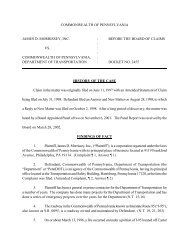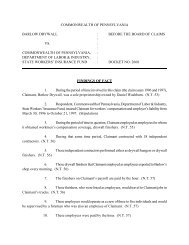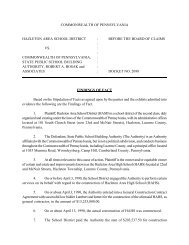3720 - Board of Claims
3720 - Board of Claims
3720 - Board of Claims
Create successful ePaper yourself
Turn your PDF publications into a flip-book with our unique Google optimized e-Paper software.
approximately five months. Actual pole relocation in Section Two and Section One eventually<br />
occurred from on or about March 25, 2002 to July 25, 2002. Complete utility pole relocation, in<br />
addition to progressing in fits and starts not at all close to the coordinated work set forth in the<br />
Construction Sequence and “Utilities” section <strong>of</strong> the Contract, did not conclude until nearly 300<br />
days later than reasonably anticipated by Intercounty.<br />
This exceedingly long delay in pole relocation, together with the start and stop progress<br />
<strong>of</strong> same, in turn, clearly delayed and disrupted Intercounty’s work throughout the length <strong>of</strong> the<br />
Project and was the cause <strong>of</strong> the Project ultimately being completed 223 days late. Specifically,<br />
the late start and slow progress <strong>of</strong> the utility pole relocation initially hindered Intercounty’s<br />
progress on the Project by causing it to run out <strong>of</strong> planned work while it performed less<br />
productive tasks and waited for poles to be moved. This was particularly evident in the Fall <strong>of</strong><br />
2001, as Intercounty’s work was then confined to Section Three by the Construction Sequence<br />
and the E & S Plan. This initial problem then became worse in November 2001. Following the<br />
Utilities’ departure from the job site and an oral request by Intercounty to demobilize in late<br />
October 2001 due to the pole relocation delay, which request was flatly rejected,<br />
Mr. Sebastianelli, in early November 2001, notified Intercounty that he would hold weekly<br />
“partnering meetings.” At these “partnering meetings” Mr. Sebastianelli changed the scheduled<br />
work plan in order to insure that Intercounty could keep working around the obstructing poles.<br />
At these meetings, which continued throughout the remainder <strong>of</strong> the Project, Mr. Sebastianelli<br />
cast aside the Construction Sequence and each week created an ad hoc list <strong>of</strong> tasks for<br />
Intercounty to perform. These new work lists were called either “Schedule <strong>of</strong> Operations” or<br />
"Weekly Schedule", and from November 2001 through the end <strong>of</strong> the Project they replaced the<br />
original Construction Sequence and dictated where and in what order Intercounty had to perform<br />
75






